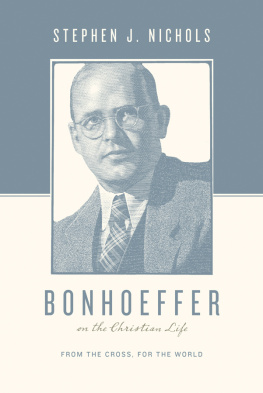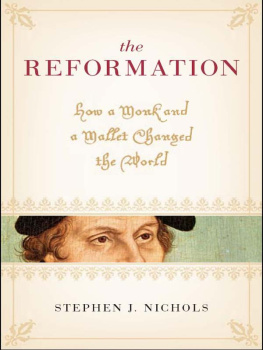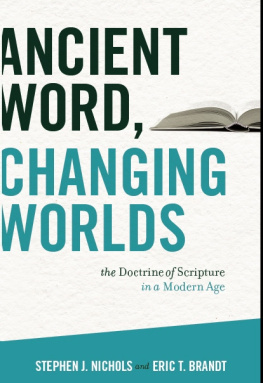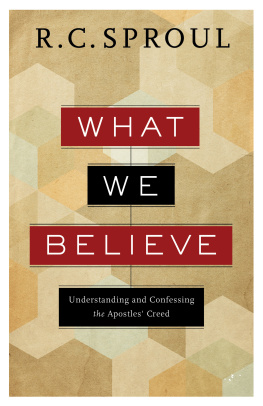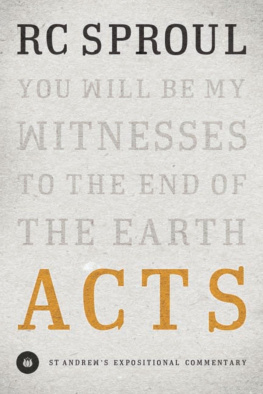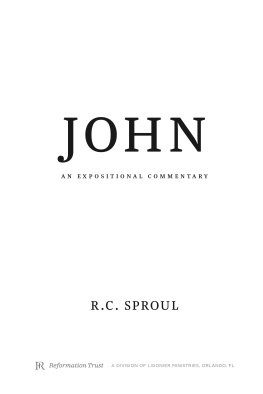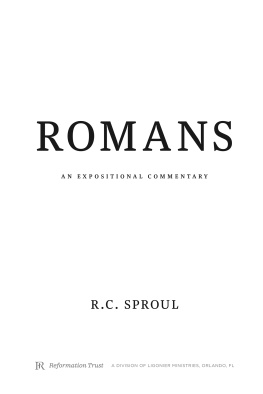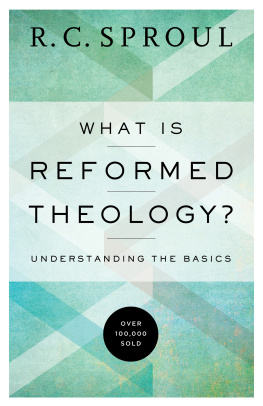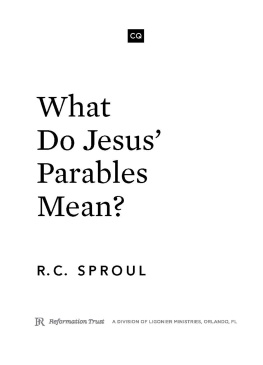Table of Contents
Landmarks
Appendix 7
Series Title | Number of Sermons |
The Gospel of Mark | |
The Gospel of Matthew | |
The Book of Romans | |
1st & 2nd Peter | |
1st & 2nd Samuel | |
Gospel of John | |
The Book of Acts | |
Names of God | |
Philippians | ? |
Luke | |
Ephesians | |
Galatians | ? |
Hebrews 1:12:4 | |
Shadows in a cave are given to change. They dance and flicker with ever-changing shape and brightness. To contemplate the truly holy and to go beyond the surface of creaturely things, we need to get out of our self-made cave and walk in the glorious light of Gods holiness.
R. C. Sproul
The Weekender section of The Tribune-Democrat for Saturday, September 20, 1980, has a large picture of R. C. on the front cover. Taken at the study center, R. C.s wearing a coat and tie and leaning back on a fence post under the headline: Dr. R. C. Sproul: Teaching People Who God Is. Four years later, the JuneJuly issue of the sardonic The Wittenburg Door ran an interview. The first question and answer were these:
Door: What does the Church need today?
Sproul: I am passionately convinced that the biggest need of the church is to develop a deeper understanding of the character of God. People need to know, cognitively and intellectually, who God is.
An advertisement in a 1979 issue of Tabletalk for R. C.s six-part teaching series on the holiness of God contains, in large Gothic script, Holy. Holy. Holy. followed by this:
Its a shame. What God repeated most we understand least.
The advertisement proceeds: In the entire Bible there is only one word that God repeated three times to describe himself. Holy. Holy. Holy. That word describes Gods most elusive and frightening characteristic: His Holiness. Its a subject so awesome that few have dared to approach it.
R. C. did not approach it. It approached him.
Recalling that pivotal moment in college, R. C. was compelled to leave the comfort and warmth of his bed in his dorm room at Westminster College. Feet crunching through snow as the clock struck midnight, R. C. entered the chapel, having passed through the oaken door under a Gothic arch. From that moment on, the holiness of God gripped R. C. It found him, and it did not let him go.
When R. C. went on the air for the first time for his national radio show, Renewing Your Mind , on October 3, 1994, the very first broadcast was the first lecture of the Holiness of God teaching series. R. C. ended the first broadcast by recalling that turning-point moment; then he delivered these last lines:
That private and personal experience that I had in that chapel was a life-changing experience for me, and it was the beginning of a lifelong pursuit of the holiness of God.... It is not only vital to my life, but is central to the biblical revelation of the character of God, and its absolutely crucial for every Christians personal growth to investigate, to reflect upon, to seek an understanding of what the Scriptures mean when they declare that God is holy.
In a Mission Statement (and a Note on the Hair)
The October 1981 edition of Tabletalk ran a unique Ask R. C. column. Those who have known R. C. over the years, or have seen video clips, have likely observed his clothing styles change and, whats more, his hairstyle change. The hair took on a life of its own. It has become part of the story. This particular column from R. C. deals with the hair directly. It was coarse, full, and flat. Then came a trip to a barber shop in Arizona. The barber, a woman, asked R. C., Why dont you let me do something with your hair? He thought to himself, You already are. Youre cutting it . But what he said was, Like what? And the rest is history. Everyone asked: What in the world did you do to your hair? That was the pressing question in the Ask R. C. column. It was the pressing question R. C. got in 1981. The response to the coiffed mane was mixed. R. C. kept track. Tongue-in-cheek, he offered:
But the opinion expressed in a following and final sentence had the last word on the matter: But... Vesta said, I love it... so it stays. To the list of influencers who truly impacted R. C.his dad, Mrs. Gregg, his coaches, Dr. Gregory, and Dr. Gerstnerwe need to add an unknown female barber in Arizona. Thats the origin of the hair. That same October 1981 issue of Tabletalk also sheds light on the origin of the mission statement of Ligonier.
The mission statement for Ligonier evolved over the years. Beginning with that October 1981 issue, the Tabletalk masthead included The Mission of Ligonier, which was:
To contribute to the cause of spiritual renewal and reformation through a teaching ministry designed to inform masses of people with Biblical content and to train key church and paraministry leaders in Biblical truth including doctrine, practice, and cultural interpretation (theology, ethics, practical theology, and apologetics).
The February 1983 issue had a new and much shorter version of the mission statement:
To teach the Christian faith to as many people as possible.
The February 1985 issue ran another new mission statement, which trended back longer:
To teach biblical truth to adult Christians and to encourage them to achieve a world and life view that will yield mature, obedient Godliness, thereby contributing to a renewal of the church and culture.
The mission statement in the late 1980s became:
To help awaken as many people as possible to the holiness of God in all its fullness.
The mission statement currently reads:
To proclaim the holiness of God in all its fullness to as many people as possible.
That underlying purpose has to do with reckoning with who God is, in His holiness, and then teaching and living that. That underlying purpose goes back to a time early in Ligoniers history when they brought in a consultant.
The final version of the evolved mission statement was the result of a collaboration with that consultant and R. C. The consultant sat with R. C. and asked him to describe himself. R. C. replied that he is a theologian. Then the consultant asked, What do you do? R. C. said that he teaches. Then the consultant asked him what he teaches, and R. C. replied that he teaches people who God is. Then the consultant asked him, Who do you teach? R. C. said he mainly teaches people in the church but also reaches and teaches people in culture. The consultant had just two more questions. First, he asked, What do people in the church most need to know about God? R. C. said, He is holy. Then the consultant asked the last question: What do people in the culture need to know about God? R. C. said, He is holy. That has always been the foundation of the underlying purpose and is reflected in the final form of the refined mission statement.
The night before the memorial service for R. C., a group of theologians and pastors who had shared many conference platforms with R. C. gathered for a reception. As different memories were brought up, John Piper, with a laser focus, thought of R. C. and the holiness of God. He exclaimed, What other ministry has the phrase the holiness of God in its mission statement?
The holiness of God was central to R. C. The doctrine that gripped him began with a personal experience, but it was nurtured and fostered by a lifetime of study and pursuit. One book that caught R. C.s attention was by the German Lutheran theologian Rudolf Otto.


